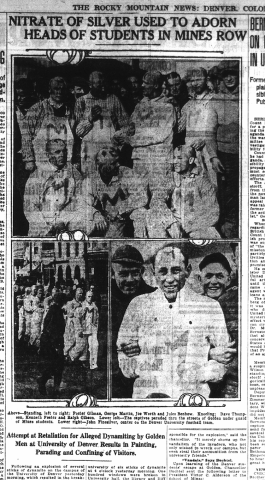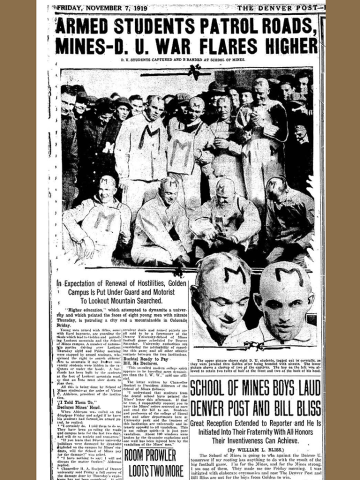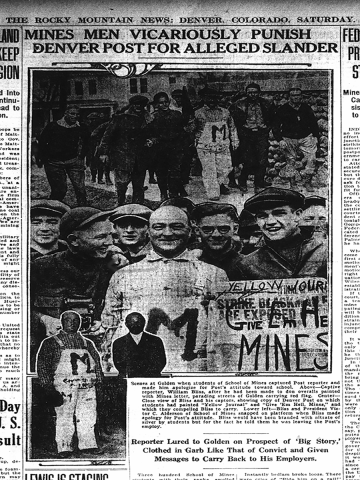The University's 1919 "War" With School of Mines
This story is from the summer 2009 edition of the University of Denver Magazine and was written by Richard Chapman. It is being republished for the 100 year anniversary of this event.
University Hall crouches like a stone lion.
Its rough walls ripple, a mane of oatmeal rock against a sleek sandstone coat. The look speaks of power and permanence and is so regal it’s easy to overlook the two dozen or so curious rectangles clinging to the sides of the building like handholds on a climbing wall.
The metal boxes aren’t adornments. They cover thick steel pins that skewer the building and bind the leonine edifice tight.
Some in the campus community know the story of the pins. A few, like James Gibson (BA ’50), grew up hearing about them from his dad, who reminisced about the pins. And the broken windows. And the dynamite. And the red paint. And the November day in 1919 when he and five DU classmates were stripped, shaved, branded and marched through the streets of Golden like prisoners of war.
Blast off
The America of 90 years ago was very different. Prohibition had just begun. Flight was in its infancy. Women couldn’t vote. World War I had just ended, and the Spanish flu pandemic was still killing millions. The White Sox threw the World Series, and fear of “anarchists and Reds” had the public in panic.
In Colorado, a bitter coal strike shivered the state and forced the governor to send troops to the mines. Record cold was reported, and the workday in Denver was limited to six hours. The University of Denver, unable to heat its buildings, closed campus for two weeks until the “coal famine” was resolved.
The only diversion was news coverage of the pursuit and capture of William Carlisle, the Parlor Car Bandit, named for his “courtly manners” during train robberies.
DU in 1919 was known as the “Ministers” or “Fighting Pastors.” The school was 55 years old and boasted 1,800 students. It had 120 faculty members, dental, law and “commerce” schools, and prided itself on being the first university west of New York to offer college credit for training Scoutmasters.
Tuition was $150.
DU had a football team but no stadium and competed in an athletic conference with CU, Colorado College, CSU (then Colorado A&M) and Colorado School of Mines.
Hazing was rampant, as were college pranks. Some were as innocent as a cow ending up in a University Hall classroom. Others were more inventive, such as when members of the Beta fraternity stuffed a sophomore named Joseph Hoery into a coffin-like wooden crate, nailed the top shut, wrapped the box with rope, then summoned a freight service to deliver the crate to a female student in Templin Hall, the women’s dormitory on the northeast corner of Josephine Street and Evans Avenue.
DU’s archrival was the School of Mines, where students so often rode through Golden firing revolvers and dropping sticks of dynamite for fun that the newspapers started calling them the “Blasters” and “Dynamiters” instead of the “Orediggers.”
So it might not have been a surprise when at 4:15 a.m. on Nov. 6, 1919, a series of huge dynamite explosions shattered the quiet DU dawn. The blasts rocked beds in Templin Hall so fiercely that residents thought there was an earthquake, according to newspaper accounts at the time. The explosions blew out about 100 windows in University Hall, the Iliff School of Theology, Carnegie Library and Memorial Chapel.
The shock wave cracked University Hall.
“If all the dynamite planted on our campus had exploded simultaneously, it would have knocked down our buildings and destroyed life,” Chancellor Henry Buchtel told the Rocky Mountain News.
Miraculously, no one was injured, and no buildings fell down.
Altogether, four bombs exploded. Ground zero was about 200 feet southwest of University Hall in an empty field where the Mary Reed Building stands today. One bomb failed to detonate — a clutch of five dynamite sticks whose fuse had been lit but which hadn’t gone off. An empty dynamite crate was found on University Boulevard.
School of Mines students were blamed.
The night before, “slight” explosions had been heard, but neither damage nor injury resulted. Signs reading “Get D.U.” and “Give ‘Em Hell, Mines” were found plastered on building walls. The assumption was that the pranksters of Wednesday evening had returned Thursday morning to make a bigger splash.
“Police say the simultaneous explosion of 25 sticks of dynamite would have caused havoc for blocks,” The Denver Post reported in its lead story on page one.
Buchtel was furious. He wasn’t alone.
A wave of indignation swept the campus, inflaming students like Ralph Gibson, a burly fullback on the football team. Gibson was a West High graduate who had survived both World War I and the Spanish flu before returning to Colorado to study dentistry at DU.
“Students figured it was up to them to exact payment for the offense against the University of Denver,” says James Gibson, Ralph’s son. “Dad was a pretty tough guy.”
The elder Gibson and others hired a car and drove to Golden with vengeance in mind. Their plan was to repaint in crimson the 104- by 107-foot white “M” on Mount Zion overlooking the School of Mines. The Mines “M” is the nation’s second-oldest mountainside monument and stood even then as a cherished symbol.
The group didn’t depart Denver until mid-morning, and though they were able to smear a large portion of the “M” with red paint, the task was far from complete when they were discovered.
Mines students, accustomed to college rivals assaulting the “M,” had set up a telescope to keep watch, The Colorado Transcript reported. It wasn’t long before the Gibson group was spotted and the alarm sounded. The DU students fled but were overwhelmed by Mines students who had set up a barricade on the road off the mountain. Both Denver papers reported that shots were fired. But no one was hit or injured, and it was later alleged that the gun had held blanks.
“They were sneaky, but not sneaky enough,” Gibson chuckles, remembering his father’s account.
The newspapers splashed the front page with photos of the captured DU students dressed in POW overalls, their heads shaved and large purplish-black “Ms” etched onto their scalps with silver nitrate, a caustic chemical that takes months to wear off.
According to the Post, the captured students “were placed under heavy guard in various fraternity houses” after being paraded through the streets of Golden “as prisoners of intercollegiate war.”
Post reporter Bill Bliss suffered the same treatment. Mines students lured Bliss to campus with promises of a “big story.” They met him in Golden, dressed him in convict overalls and forced him to walk through the streets of Golden carrying a red flag and a copy of the newspaper on which had been written “Yellow Journal.” Bliss was spared a head shaving because he was already bald; he was spared the silver nitrate “M” by telling students he planned to quit the paper and go back East.
The humiliation climaxed in a mass meeting on the Mines campus presided over by school President Victor Alderson. Bliss contritely apologized for his newspaper, the Rocky Mountain News gleefully reported. And after much hooting and chauvinistic speeches, the Mines students sent him back to Denver to communicate a warning that if the Post’s owners didn’t “cease their slurring attacks, the Miners would give the proprietors a taste of the clowning they gave the reporter.”
Gibson and the other DU students were released later that evening.
“I’m sure he was upset, but I don’t think greatly so,” James Gibson speculates. “He was relatively good-natured and took the punishment the same way.”
Today, similar behavior would result in instant police involvement and serious criminal charges, points out Karen Steinhauser, a former prosecutor and professor at the Sturm College of Law who now is a criminal defense attorney at Isaacson Rosenbaum. Charges could include kidnapping, false imprisonment, conspiracy, vandalism, weapons violations and assault, and they would have been broadly applied, with punishments measured in years.
But in 1919, America’s skin was thicker. “People did not look to the criminal justice system back then to settle everything,” Steinhauser says. “They found other ways.”
The first of these “other ways” occurred in Denver two days later, when DU and Mines were scheduled to face off in football.
“Never before has the bitter feeling between the schools reached the blood heat that is rife now,” the Post wrote. “Late Friday night representatives of the two schools met and agreed there would be no fighting … to leave it entirely in the hands of the football teams.”
Denver’s police chief threatened to cancel the game if trouble between the schools erupted, and DU trustees debated whether the University should sever its athletic ties with Mines.
Chancellor Buchtel favored settling things on the football field and predicted that DU would exact the necessary vengeance for the dynamiting “by grinding the Mines to brick dust on the gridiron.”
Good sports
Game day dawned cold and white. Nearly 5,000 people arrived at the Broadway Park field in snow and freezing temperatures for the afternoon clash. It was a grand day for a grudge match; miserable for football.
“Snow made fast playing almost impossible, fumbling frequent and field goals out of the question,” the News reported.
Still, it was an impressive game. Rick Ricketson of the Post gushed that “harder fought battles haven’t been seen in Denver.” Nor cleaner games, he added, noting that penalties were few, sportsmanship abundant, sideline cheers “good natured,” and “the bitter, destructive feeling between the two schools not exhibited” even though both teams “flew at each other like hungry devouring beasts.”
All that was missing was resolution. The game ended in a 0-0 tie.
Hard feelings remained. The day after the football game an early-morning powder charge blew off about 20 square feet of the “M” on Mount Zion. The blast rocked houses in Golden. A heavy snowstorm prevented anyone from being caught, but DU students were blamed.
“But for the fact that the perpetrators did not know how to place the charge, the famous Mines ‘M’ on Mount Zion would have been destroyed,” the Transcript reported.
Mines students armed themselves with rifles and bayonets and commenced patrolling their campus and the surrounding roads. The Post reported that the patrols had been set up with Mines President Alderson’s permission.
Students piled desks and debris on the bridge leading from Golden to Lookout Mountain and stopped cars for inspections, lest DU students be concealed. Civil rights were ignored.
By Monday, Nov. 10, Colorado Gov. Oliver Shoup had had enough. The college war had “disgraced the state,” he said, and he ordered the lawlessness to cease.
“I hope it will not be necessary to send troops to Denver University and the School of Mines in order to suppress lawlessness,” Shoup said.
The saber rattling worked. Student leaders at both schools appointed representatives to meet, ascertain facts and lay blame.
What began as campus defiance softened to regret, especially at Mines, where students began to understand how the dynamiting of DU had eroded the standing of their school. Ideas on how to improve relations included everything from a get-together, dance and “ceremonial burying of the hatchet” to a field day with a giant tug-of-war between the student bodies.
In Denver, a grand jury began summoning students, taking testimony and fanning speculation there would be “wholesale indictments” before it turned its investigative eye toward “red activities in Denver.”
At Mines, students quickly negotiated a treaty with CU in anticipation of their forthcoming football game on Thanksgiving Day. The schools agreed to “eliminate paint, dynamite and all other weapons of destruction,” the Post reported.
At DU, the focus turned to fundraising and the Fighting Parsons’ bid to go “tiger hunting” at Colorado College.
“The game with the School of Mines has keyed and stirred the Ministers to anxiously count on a victory this week,” the Post wrote.
DU lost 38-0.
The fundraising, which included a door-to-door canvass of Observatory Park, turned out much better, such that the University’s fiscal emergency was eased and the endowment bolstered.
The football team, meanwhile, looked forward to last-game redemption against Phillips University, a Disciples of Christ institution in Enid, Okla. The Haymakers’ coach was nicknamed the Human Bullet.
DU lost 58-0.
Back on campus, life returned to normal. University Hall was pinned together and today is perfectly safe. The broken windows were replaced and the building redecorated. The following fall, DU exacted revenge for the dynamiting by beating Mines in football 16-6.
Peace reigned until the late 1920s, when Clarion editor Robert Selig (BA ’32) led a group of DU students to Mines and “blew the M off the mountain,” recalls his son, Robert Selig Jr.
The ringleader was caught, stripped, shaved, branded and his “private parts” covered in plaster of Paris, the junior Selig recounts. His father was “dropped off at 16th Street on a cold, icy night.”
The elder Selig went on to a successful business career followed by 16 years of service on the DU Board of Trustees. And in 1961, he received the Evans Award, the University’s highest alumni honor.










